NASA's Lunar Reconnaissance Orbiter launched 10 years ago today (June 18, 2009), at a time when NASA was toying with going back to the moon. A decade later, the agency now has a tight deadline of 2024 to land people on the lunar surface, and LRO's data will likely guide the way.
LRO is best known as a water hunter and high-definition mapper of the lunar surface. Both water and clear maps are essential for any human missions. Permanent settlements on the moon will do better if settlers can "live off the land" and use frozen water on site, because that will mean they won't have to launch so much weight from Earth. And when it comes to finding a good spot to do exploration, LRO's images can't be beat. They're so precise that they even picked up details of the Apollo moon landing sites, each of which humans visited nearly half a century ago.
LRO carries a suite of cameras and instruments to reveal more about the moon's environment. Those tools include an ultraviolet instrument that could sense surface ice and frost, a cosmic ray telescope to measure radiation levels, and a radiometer to peer underneath the thick lunar dust.
Related: Latest Moon Photos from NASA's Lunar Reconnaissance Orbiter
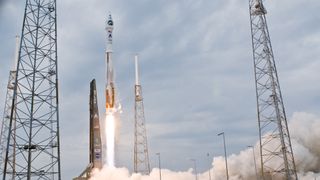
NASA's Lunar Reconnaissance Orbiter (LRO) and Lunar Crater Observation and Sensing Satellite (LCROSS) lifted off together from Launch Complex 41 at Cape Canaveral Air Force Station in Florida atop an Atlas 5 rocket on June 18, 2009, at 5:32 p.m. EDT (2132 GMT).
(Image: © Tom Farrar, Kevin O'Connell/NASA)
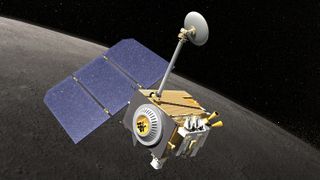
An artist's concept of the LRO as it orbits the moon.
(Image: © NASA)
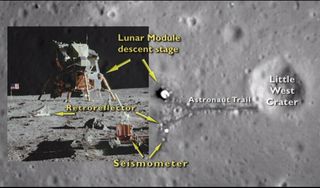
NASA's Lunar Reconnaissance Orbiter caught sight of the landing site of the Apollo 11 moon mission.
(Image: © NASA's Scientific Visualization Studio)
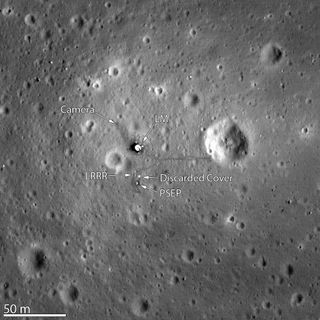
The Lunar Reconnaissance Orbiter Camera snapped its best look yet of the Apollo 11 landing site on the moon. The image, which was released on March 7, 2012, even shows the remnants of Neil Armstrong and Buzz Aldrin's historic first steps on the surface around the Lunar Module.
(Image: © NASA/GSFC/Arizona State University)
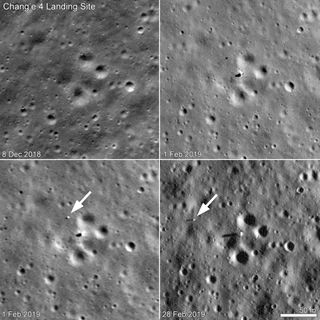
China's Chang'e 4 rover, called Yutu 2, moved between Feb. 1 and Feb. 28, 2019. The upper left panel shows the landing site before Chang’e 4’s Jan. 2 touchdown; the upper right panel is the best-resolution photo of the lander and rover taken so far. The lower left image was taken six hours later. The most recent view, in the lower right, shows that Yutu 2 traversed 150 feet (46 meters) to the west during the month of February.
(Image: © NASA/GSFC/Arizona State University)
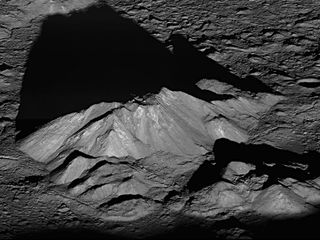
On June 10, 2011, NASA's Lunar Reconnaissance Orbiter angled its orbit 65° to the west, allowing the spacecraft's cameras to capture a sunrise view of the moon's Tycho crater. Tycho is located at 43.37°S, 348.68°E, and is about 51 miles (82 kilometers) in diameter. The summit of the central peak is 1.24 miles (2 kilometers) above the crater floor. The distance from Tycho's floor to its rim is about 2.92 miles (4.7 kilometers). Tycho crater's central peak complex, shown here, is about 9.3 miles (15 km) wide, left to right (southeast to northwest in this view).
(Image: © NASA/Goddard Space Flight Center/Arizona State University)
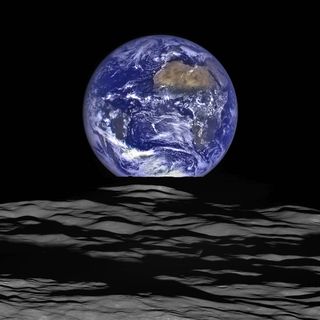
A gorgeous shot of Earth with the moon in the foreground, captured on Oct. 12, 2015 by NASA's Lunar Reconnaissance Orbiter spacecraft.
(Image: © NASA/Goddard/Arizona State University)
The LRO also once carried a pair of companion spacecraft called LCROSS, which stands for Lunar Crater Observation and Sensing Satellite. The LCROSS probes had a short mission, but the project assisted with an amazing find after the twin spacecraft deliberately crashed into the surface in 2009; the cosmic smashup, which LRO witnessed from orbit, revealed that the lunar south pole hosted a lot of water ice in Cabeus crater. A decade later, multiple observations of water by LRO suggest that this very region might be the best spot for landing thirsty astronauts.
LRO additionally serves as a nifty technology demonstrator. For example, robotic probes across the universe use radio communication to stay in touch with Earth. This is a reliable but somewhat slow way of sending information from distant outposts. In 2013, LRO tried something new, gamely receiving a copy of the famous Leonardo da Vinci "Mona Lisa" painting by laser. The venture was so successful that NASA predicted lasers could serve as a backup for radio communications on some spacecraft.
While the LRO spacecraft remains in good health, a regular natural phenomenon does threaten the probe from time to time. Lunar eclipses can cut off the spacecraft from harvesting solar power.
When LRO was younger, NASA would have it spend such eclipses mapping temperature changes on the lunar surface; that's how scientists discovered that the top 0.4 to 0.8 inches (1 to 2 centimeters) below the lunar surface rapidly change temperature during these events.
These days, however, the agency prefers to shut off the nonessential instruments on LRO to save power. "I don't want to say [eclipses] are risky," LRO project scientist Noah Petro told Space.com in a January interview just before an eclipse. "They are unusual operations, and that is always a challenge."
After 10 years of operations and thousands of images to the spacecraft's name, it's hard to pick just a few LRO photos to sum up the spacecraft's career to date. But readers may best remember images that spotted a Chinese spacecraft on the far side of the moon, revealed that the U.S. flags at Apollo sites were still standing in 2012, surveyed "lunar pits" from above and provided so many high-definition views of the moon's surface — including this spectacular image of the lunar north pole taken in 2014.
Follow Elizabeth Howell on Twitter @howellspace. Follow us on Twitter @Spacedotcom and on Facebook.
https://www.space.com/nasa-lunar-reconnaissance-orbiter-10th-anniversary.html
2019-06-18 11:09:00Z
CBMiTWh0dHBzOi8vd3d3LnNwYWNlLmNvbS9uYXNhLWx1bmFyLXJlY29ubmFpc3NhbmNlLW9yYml0ZXItMTB0aC1hbm5pdmVyc2FyeS5odG1s0gFRaHR0cHM6Ly93d3cuc3BhY2UuY29tL2FtcC9uYXNhLWx1bmFyLXJlY29ubmFpc3NhbmNlLW9yYml0ZXItMTB0aC1hbm5pdmVyc2FyeS5odG1s
Bagikan Berita Ini














0 Response to "NASA's Lunar Reconnaissance Orbiter Turns 10, with Lessons for Moon Missions - Space.com"
Post a Comment